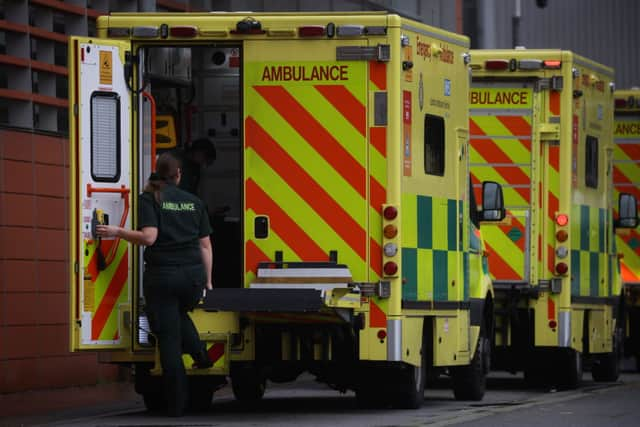NHS to get thousands more hospital beds and 800 new ambulances in plan to ‘fix’ emergency care
and live on Freeview channel 276
The government has promised thousands more hospital beds and 800 new ambulances as part of a plan to “fix” emergency care as the NHS continues to battle severe pressures.
Rishi Sunak has described the proposals as “ambitious and credible”, but he faces warnings that the outstanding issues of staff shortages and NHS funding must be grappled with.
Advertisement
Hide AdAdvertisement
Hide AdThe NHS and government said 800 new ambulances, including 100 specialist mental health vehicles, and 5,000 more sustainable hospital beds would be backed by a dedicated £1 billion fund.
A key part of the plan is to expand urgent care in the community to keep patients away from under-strain hospitals, and instead see them treated at home. It will see same-day emergency care units, staffed by consultants and nurses, open in every hospital with a major A&E department. Ministers hope the measure will see thousands of people each week avoiding an overnight stay in hospital.
There are also plans for pilots of new approaches to NHS step-down care, with patients receiving rehabilitation and physiotherapy at home in some instances.


Sunak, who has made cutting waiting times in the NHS one of his five priorities as Prime Minister, said: “Urgent and emergency care is facing serious challenges but we have an ambitious and credible plan to fix it.
Advertisement
Hide AdAdvertisement
Hide Ad“It will take time to get there but our plan will cut long waiting times by increasing the number of ambulances, staff and beds – stopping the bottlenecks outside A&E and making sure patients are seen and discharged quickly.”
But Labour has said the plans are not enough to tackle the problems in the NHS and accused the government of “watering down standards for patients”.
Wes Streeting, Labour’s shadow health secretary, dismissed the initial details of the plan, stating: “Now Rishi Sunak is watering down standards for patients. Even if the NHS achieves his targets, patients will be left waiting longer than is safe.
“Expecting the Conservatives to fix the crisis in the NHS is like expecting an arsonist to put out the fire they started, it is just not going to happen.”
Advertisement
Hide AdAdvertisement
Hide Ad‘Fixing our NHS is no means task’
The Department of Health said this weekend that 3,000 “hospital at home” beds will be created before next winter, with hopes that about 50,000 people a month could eventually be cared for at home each month.
It comes as health officials increasingly look to virtual wards as part of the solution to combat NHS pressures. It will see patients treated from home while monitored by medics either through daily visits or video calls.
Health Secretary Steve Barclay, writing in the Daily Telegraph, warned that “fixing our NHS is no mean task”. Suggesting that he would like to see greater transparency in the health service, he wrote: “I want NHS managers and the wider public to have access to the same facts from the front line, starting with publishing the number of 12-hour waits from the time of arrival in A&E from April.” He also says he wants to “hold true to that promise of an NHS that is always there for us”.
The plan also sets out staffing and workforce reforms, with plans to give NHS more flexibility and make it easier for staff to move between hospitals and work in services like 111, while creating more options for call handlers to work from home.
Advertisement
Hide AdAdvertisement
Hide AdThere will also be efforts to expand the number of emergency medical technicians, alongside greater use of student and apprentice paramedics, as well as training more staff in mental health.
Ministers want to ensure that 76% of A&E patients are seen within four hours by next March, while category two ambulance response times – such as suspected strokes, heart attacks, burns and epilepsy – get to an average of 30 minutes over the next year.
Matthew Taylor, chief executive of the NHS Confederation, called it an “important road-map”, but warned that success would “depend on NHS staff continuing to go above and beyond, but also on concerted action to reduce the numbers of people needing to come into contact with emergency and urgent care services in the first place.”
Dr Adrian Boyle, president of the Royal College of Emergency Medicine, welcomed most of the proposals, but warned that “the implementation and results are what really matter”.
Advertisement
Hide AdAdvertisement
Hide AdThe plan comes as Sunak’s government is locked in a bitter and ongoing dispute with nurses and ambulance workers over pay and conditions, with further walkouts planned for February.
Patricia Marquis, the Royal College of Nursing’s director for England, said: “More hospital beds and more community and social care services are desperately needed to ensure patients get the right care in the right place at the right time.
“But the real problem is the lack of staff. Extra beds are only safe when there are enough nurses for the patients in them. And because of the workforce crisis, existing services are unsafe.”
Comment Guidelines
National World encourages reader discussion on our stories. User feedback, insights and back-and-forth exchanges add a rich layer of context to reporting. Please review our Community Guidelines before commenting.
